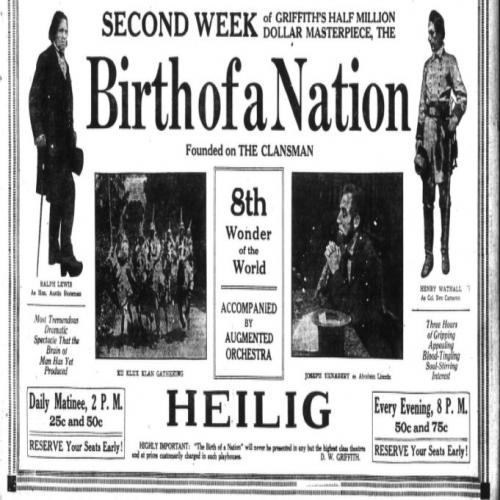The release of The Birth of A Nation (D.W. Griffith, 1915) around the country made big waves. D.W. Griffith and James Q. Clemmer were the men at the helm, adapting the movie from “The Clansman” by Thomas Dixon. The film practically advertised itself by its grand feats of production for the time. As detailed in Kimberley Mangun’s article, “As Citizens of Portland We Must Protest”, the film “…had taken eight months to shoot, featured a cast of eighteen thousand, and cost $500,000 - more than ten times its initial budget. It took three hours to view the twelve reels, three times longer than other films playing in 19151.” These facts featured prominently in the advertisements for the Heilig, a theater in Portland, commanding attention with such claims of grandeur as “8th Wonder of the World." While these boats doubtlessly were effective as promotion, they also gathered attention on the views presented in the film. The film is comprised of major events, such as “…the Civil War, Reconstruction, and rise of the Ku Klux Klan2”. It should be obvious the tack the film chose by documenting the rise of the Klu Klux Klan as a major part of the film. This contributed greatly to racial tensions in areas the film debuted (such as the Heilig). A reviewer named Francis Hackett, working for the newspaper “New Republic”, criticized the narrative of the film: “The effect of these lines, reinforced by adroit quotations from Woodrow Wilson and repeated assurances of impartiality and goodwill, is to arouse in the audience a strong sense of the evil possibilities of the negro and the extreme propriety and godliness of the Ku Klux Klan3”. This mixture of impressive promotion and racial tension at the theater set the stage for Birth of A Nation becoming one of the most infamous films in history.
Citations
1. Mangun, Kimberley. “‘As Citizens of Portland We Must Protest’: Beatrice Morrow Cannady and the African American Response to D.w. Griffith's ‘Masterpiece.’” Oregon Historical Quarterly, October 1, 2006. https://www.jstor.org/stable/20615659.
2. Ibid.
3. Ibid.
4. University of Oregon, and Knight Library. “The Oregon Daily Journal. (Portland, Or.) 1902-1972, September 05, 1915, Page 31, Image 31.” The Oregon daily journal. (Portland, Or.) 1902-1972, September 05, 1915, Page 31, Image 31 ". Historic Oregon Newspapers.
